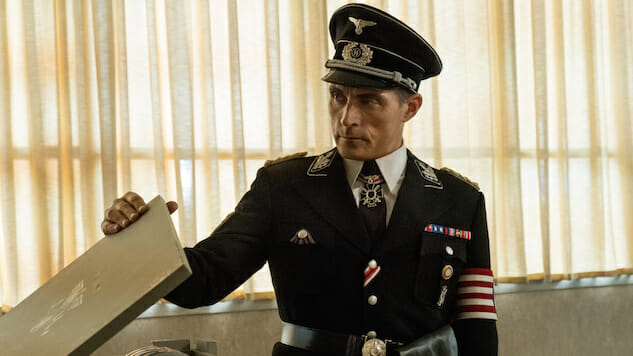How Amazon’s The Man in the High Castle Creates an American Reich
Photo: Liane Hentscher/Amazon Prime Video
“Sieg heil! Sieg heil! Sieg heil!”
The sound is faint across the lot’s expanse, but it is unmistakable. As is the soldiers’ stiff-armed salute, performed in unison before an imposing proscenium, or the “patriotic” bunting, a marriage of swastikas with the red, white and blue. A man roars from the stage, his voice throaty, choking: “Today,” he says, “history ends, and the future begins!”
The man is not Heinrich Himmler. The year is not 1962. And I am not attending an American Nazi rally in the environs of Vancouver, British Columbia. But I might be, were it not for the green screens on cranes that will transform this semi-industrial wasteland into a teeming New York street, and that’s exactly the point: The strength of Amazon’s science fiction / counterfactual history The Man in the High Castle, which imagines a world in which the Axis won World War II, is its iconographic invention of an American Reich. (Its grasp on the relationship between postwar California and imperial Japan turns out to be much, much shakier.) Now entering its third season, the series, developed by Frank Spotniz from Philip K. Dick’s 1962 novel, remains a useful reminder of the power of symbols, as I wrote of Season One:
“Even the title sequence, pairing the whir of moving celluloid with a chilling rendition of “Edelweiss”—made famous by the anti-fascist classic The Sound of Music—comes to suggest the incremental changes by which the culture we love might become a culture that terrifies us. It’s a lesson worth keeping in mind not only for the imagined past of The Man in the High Castle, but also for the many possible futures of the fallen world it doesn’t depict: ours.
As production designer Drew Boughton explains, speaking over the echoes of the rally scene being filmed in the distance, it’s the uncanniness of the series’ aesthetic, its “almost normal” aspect, that distinguishes it from other period pieces on TV. (Case in point: Despite having visited the sets of series about zombies, alien invasions, and Russian spies, I was completely unprepared for the surreal sight of men in dark suits and pinch-front fedoras, bright swastika armbands looped around their biceps, waiting in line for lunch or standing next to me at the urinals.) Citing the pro-Nazi American Bund in the 1930s, the Brutalist architecture of the 1950s and 1960s, nostalgia for the Old West—in a “neutral zone” trading post set that’s new to The Man in the High Castle this season—and Mad Men’s glittering New York, Boughton draws on a range of influences for the series’ heady, quasi-historical brew.
“We’re making something that is this weird bastard mix of American history and Nazi history,” he says, “to create this kind of weird nightmare.”
-

-

-

-

-

-

-

-

-

-

-

-

-

-

-

-

-

-

-

-

-

-

-

-

-

-

-

-

-

-

-

-

-

-

-

-

-

-

-

-








































